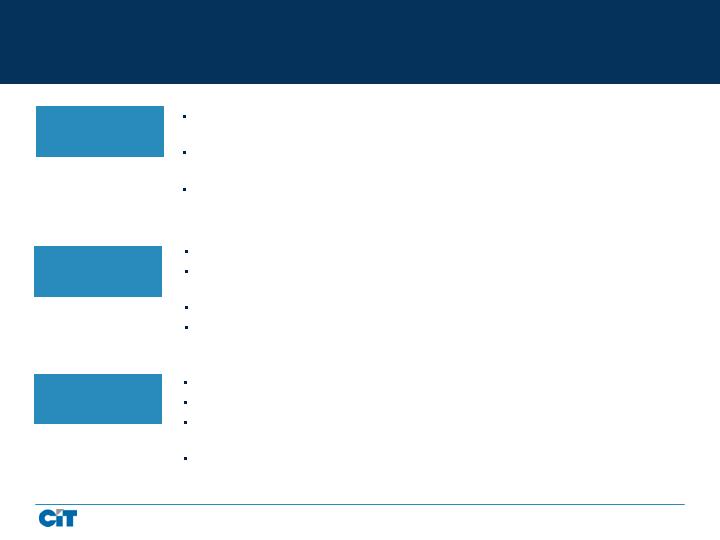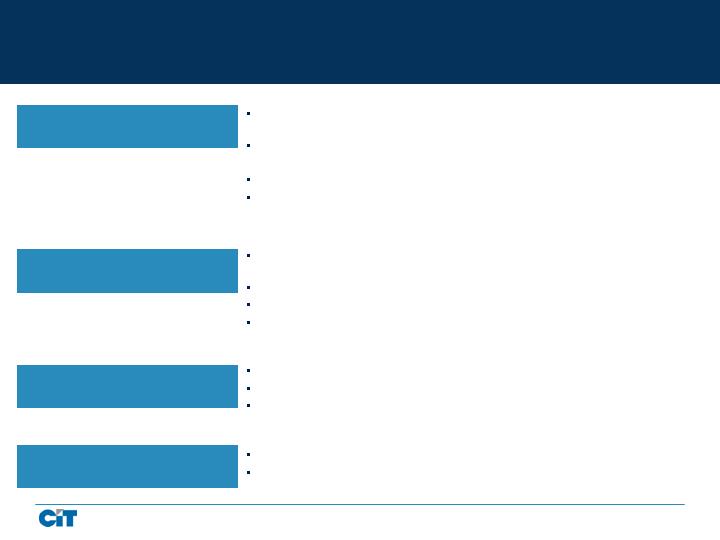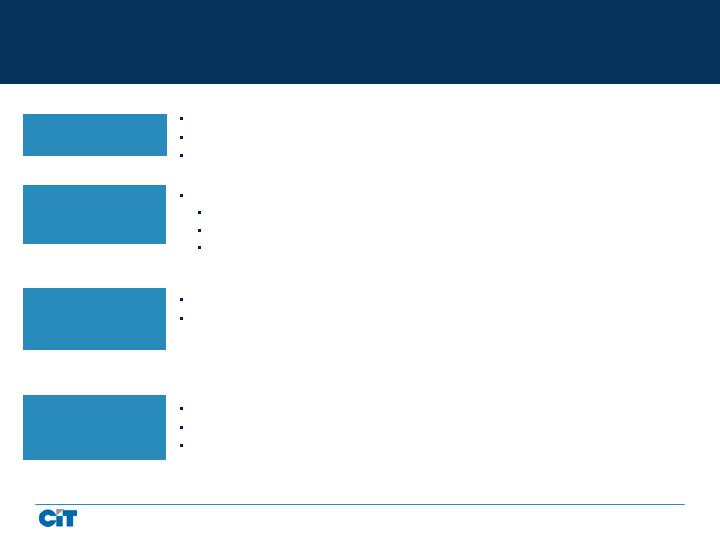- CIT Dashboard
- Financials
- Filings
-
Holdings
- Transcripts
- ETFs
- Insider
- Institutional
- Shorts
-
8-K Filing
Cit (CIT) 8-KOther Events
Filed: 18 Dec 09, 12:00am

®
CIT Update
December 2009
Exhibit 99.1

Important Notices
This presentation contains forward-looking statements within the meaning of applicable federal securities laws that are
based upon our current expectations and assumptions concerning future events, which are subject to a number of risks
and uncertainties that could cause actual results to differ materially from those anticipated. The words “expect,”
“anticipate,” “estimate,” “forecast,” “initiative,” “objective,” “plan,” “goal,” “project,” “outlook,” “priorities,” “target,” “intend,”
“evaluate,” “pursue,” “commence,” “seek,” “may,” “would,” “could,” “should,” “believe,” “potential,” “continue,” or the
negative of any of those words or similar expressions is intended to identify forward-looking statements. All statements
contained in this presentation, other than statements of historical fact, including without limitation, statements about our
plans, strategies, prospects and expectations regarding future events and our financial performance, are forward-looking
statements that involve certain risks and uncertainties. While these statements represent our current judgment on what
the future may hold, and we believe these judgments are reasonable, these statements are not guarantees of any
events or financial results, and our actual results may differ materially. Important factors that could cause our actual
results to be materially different from our expectations include, among others, the risk that CIT is unsuccessful in its
efforts to complete the remaining stages of its business restructuring, the risk that CIT is delayed in completing its
management changes, the risk that CIT is delayed in completing its transition to a bank-centric business model, and the
risk that CIT continues to be subject to liquidity constraints and higher funding costs. Further, there is a risk that the
valuations resulting from our fresh start accounting analysis, which are inherently uncertain and still subject to
change, will differ significantly from our expectations, due to the complexity of the valuation process, the degree of
judgment required, and the amount of work still remaining. Accordingly, you should not place undue reliance on the
forward-looking statements contained in this presentation. These forward-looking statements speak only as of the date
on which the statements were made. CIT undertakes no obligation to update publicly or otherwise revise any forward-
looking statements, except where expressly required by law.
This presentation is derived from CIT's publicly available information and is to be used solely as part of CIT
management's continuing investor communications program. This presentation shall not constitute an offer or
solicitation in connection with any securities.

Restructuring Overview /
Update

Restructuring Update
CIT emerged from bankruptcy on December 10, 2009, less than 6 weeks after filing
Court-supervised process allowed the Company to achieve several important objectives:
Substantial debt reduction
Improved capital levels
Significant liquidity runway
Franchise value preserved during expedited process
Progress on corporate governance initiatives
Business optimization strategy under development

Restructuring Objectives on Track
Target capital structure with significantly
less leverage
Establish capital ratios in excess of
regulatory standards and more in-line with
financially sound peers
Defer liquidity demands through debt
restructuring
Reduce reliance on capital markets
Position Company for return to profitability
and investment grade ratings
Optimize portfolio of businesses
Move eligible businesses into CIT Bank*
Transition to a bank-centric funding
model*
Maintain and build key client relationships
in core franchises
Align expense base with smaller scale
Business Model
Financial Strength
= Achieved
* Subject to regulatory approval

Phased Approach to Restructuring
Recapitalization Allows for Measured Approach to Phase III
Implement governance and
leadership changes
Transition to smaller company
focused on small- and mid- sized
businesses
Transition to a bank-centric
business model*
Optimize value of non-bank eligible
businesses
Align expense base with smaller
scale
Launched dual path restructuring
plan Oct 1st
Overwhelming support for
prepackaged plan of reorganization
Voluntary prepackaged bankruptcy
filed Nov 1st
Plan of reorganization confirmed
Dec 8th
Emerged Dec 10th with significantly
improved liquidity and capital profile
Liquidity stress peaked after
government support was not
received in July 2009
Obtained $3B senior secured credit
facility from certain large
bondholders in July 2009
Completed successful tender offer
for $1B of debt maturities in August
2009
Completed $4.5B expansion to
senior secured credit facility in
October 2009
Phase III (In Process)
Optimize Business Model
Phase II (Complete)
Recapitalize Balance Sheet
Phase I (Complete)
Address Liquidity Challenge
* Subject to regulatory approval

Highly Successful Plan of Reorganization
Overwhelming Creditor Support
Participation by approximately $28B or 83% of debt holders solicited
Over 92% of principal amount voted was in favor of Plan of Reorganization
Broad support from both Institutional and Retail holders
Minimal Business Disruption
Only two non-operating legal entities filed; operating entities unaffected and have significant
liquidity to support clients
40-day court process
Significantly Improved Liquidity and Capital Profile
Reduced aggregate debt balances by approximately $10.5B
Limited debt maturities until 2012
Cancelled all pre-existing preferred and common stock
Issued new common stock (listed on NYSE) to bondholders
Bolstered capital position

Capital Structure Impact from Restructuring
(1) 10Q table updated to reflect known restructuring outcomes including the collateralization of select international BU debt
(2) Does not include the $4.5B expansion facility completed in October 2009
(3) Remaining senior unsecured notes principally include long-dated retail notes, international BU debt and FAS 133 MTM offsets
Total Debt
New Series B Notes
New Series A Notes
Subordinated notes and equity units
Senior unsecured notes
Unsecured bank credit facilities
Secured credit facility (2)
Secured borrowings
44,315
(10,430)
54,745
2,149
2,149
-
21,036
21,036
-
-
(2,099)
2,099
1,121
(28,967)
30,088
-
(3,100)
3,100
2,862
-
2,862
$17,147
550
$16,597
Pro-forma
9/30 B/S
Restructuring
Impact
Reported
9/30 B/S
Pro-forma September 30, 2009 Debt Balances(1)
Pro-forma debt amounts above are post restructuring, pre-fresh start accounting estimates and
are subject to change
All pre-existing common and preferred obligations eliminated
Significant capital generated through debt extinguishment
200 million new common shares issued to debt holders
(3)

Enhanced Liquidity Profile
Extended debt maturity profile
Strong cash position upon emergence
Able to reinvest all Trade, Vendor and SBL portfolio cash flows into the businesses prior to platform
transfers into CIT Bank*
No limitation on ability to fund existing commitments
* Subject to regulatory approval
** 2012 maturities include $4.5 billion expansion senior credit facility issued Oct 2009 and extendible to 2013
***Unsecured maturities exclude deposits, and FAS 133 mark-to-market and discount
Pro-forma Debt Maturity Profile at 9/30/09
Pre
Post
Q4-09
2010
2011
2012**
Restructuring
Pre
Post
Restructuring
Pre
Post
Restructuring
Pre
Post
Restructuring
Unsecured Debt***
Secured Debt
($in Billions)
$3.3
$1.9
$12.2
$4.4
$8.2
$1.9
$12.4
$8.6

Key Terms of New Debt Securities
Senior Secured
Second Lien
Notes
Senior Secured
Second Lien
Notes
Senior Secured
First Lien
Term Loan
Senior Secured
First Lien
Term Loan
Type
103.5 call premium
for year 1
102 call premium
for year 2
Cash sweep
provision
103.5 call
premium for
year 1
102 call
premium for
year 2
Cash sweep
provision
102 call premium
for year 1
2.5x fair value
collateral coverage
Cash sweep
provision
2% exit fee
2.5x fair value
collateral coverage
Cash sweep
provision
Other Terms
10.25%
(fixed)
7.0%
(fixed)
LIBOR + 7.5%
(2% LIBOR floor)
LIBOR + 10%
(3% LIBOR floor)
Rate
2013 - $0.2B
2014 - $0.3B
2015 - $0.3B
2016 - $0.5B
2017 - $0.8B
2013 - $2.1B
2014 - $3.2B
2015 - $3.2B
2016 - $5.3B
2017 - $7.4B
2012
(1-year extension option)
2012
Maturity
$2.1B
$21B
$4.5B
$3B
Principal Outstanding(1)
Series B Notes
Series A Notes
Sr. Credit Facility
Tranche 2
Sr. Credit Facility
Tranche 1
(1) Senior Credit Facility Tranche 1 issued July 2009 and Tranche 2 issued October 2009; outstandings of Series A and B Notes at emergence.

Cash Sweep Mechanism
Accelerate repayment of first and second lien debt with excess cash while preserving operational flexibility
Excess cash includes collections from owned assets in Student Lending, Corporate Finance (ex. SBL)
and Transportation, net of debt service, operating expenses, servicing costs and payments on certain
operating leases
Collections in Trade Finance, Vendor Finance – U.S. and Small Business Lending (“SBL”) are
available to fund the businesses and not included in sweep until the platforms are transferred into CIT
Bank
Also excludes cash collections in Vendor Finance – International, regulated entities (incl. CIT Bank),
certain other subsidiaries, restricted accounts, and cash held by or for third parties
Allows for normal course business activity at the Bank Holding Company including:
Maintain up to $500 MM of unrestricted and available cash at all times
Reinvestments into Corporate Finance (excluding SBL) and Transportation of up to $500 MM in any
12 month period
Discretionary CIT Bank investments of up to $400 MM per 12 month period
Debt service obligations, including recourse debt obligations at subsidiaries
Funding of existing contractual commitments in Corporate Finance and Transportation (e.g. railcar &
aircraft deliveries)
Required CIT Bank investments
Reasonable efforts to use cash balances > $1.5B to prepay debt after covering liquidity needs for the
upcoming quarter

Fresh Start Accounting Overview
Financial statements will be impacted significantly by Fresh Start Accounting (FSA)
FSA will be adopted in the fourth quarter of 2009 and will be finalized with the filing of the 2009 10-K
Assets and liabilities will be marked to “estimated fair value”
Receivable valuations to incorporate existing loan loss reserve
Lower near-term charge-offs due to netting of existing loan loss reserve in fresh start value
Yield adjustments accreted into interest income over asset life
Debt adjustments amortized / accreted into interest expense over debt life
Equity value will be determined as part of the FSA process
Offering Memorandum included $5 - $11B valuation range based on 3rd party analysis
FSA requires entire enterprise to be marked initially to estimated fair value; FAS 157 Fair Value
Footnote only values financial assets and liabilities (excludes operating leases)

Fresh Start Accounting Valuations per Offering Memorandum
Original Plan of Reorganization Assumptions
Asset carrying value assumed to be reduced by
$12.5B (~20%)
Allowance for credit losses reversed as loans
marked to fair value
Debt carrying value reduced by $6.5B based on
assumed initial trading values of:
100 cents for new first lien debt
80 cents for new second lien debt
87 cents for other secured borrowing
Pre-existing common stock and preferred interests
cancelled
Shareholders’ equity valuation range of $5-$11B
Valuation Trends Since Original Plan
Initial new common equity trading value within
valuation range
Also will use market value comparables (e.g.
price/book, discounted cash flow, etc.)
Income Statement
Receivable markdown (other than specific credit reserves) to be accreted over life of assets, creating non-cash interest income
Operating lease equipment markdown reduces depreciation expense over the remaining life of the asset
Original issue discount (OID) created due to mark-down of debt to be amortized over life of debt, creating non-cash interest
expense
Tax NOL carry forwards will be reduced by cancellation of indebtedness income; remaining NOL balance expected for future
use
Asset values improving
Credit trends continue to weigh on values
Initial actual secured debt trading values are higher
than assumed

Business Update

Market Leader in Small Business and Middle-Market Financing
Trade
Finance
Factoring, lending, receivables management and trade finance to
companies in retail supply chain
Vendor
Finance
Financing and leasing solutions to manufacturers and distributors
around the globe. Operations in Americas, Europe, Asia and South
Pacific
Mgd. Assets: $4B
Market Rank: #1
Mgd. Assets: $12B
Market Rank: Top 3*
Managed Assets data as of 9/30/2009
Market ranks as of 2008
* Represents ranking for US Office Products/Tech market; exact global ranking data unavailable
Corporate
Finance
Lending, leasing and other financial and advisory services to middle
market companies (including SBA business), with focus on specific
industries (e.g., Healthcare, Communications, Media, Entertainment,
Energy, Retail)
Mgd. Assets: $18B
Market Rank: N/A
Transportation
Finance
Lending, leasing and advisory services to transportation industry,
principally aerospace and rail
Mgd. Assets: $15B
Market Rank: #3

Trade Finance – Overview and Strategy Update
Traditional factoring volumes down due to soft macro-economic conditions and
concerns over CIT bankruptcy
Product migration away from traditional factoring toward deferred purchase
and credit guaranty contracts to mitigate perceived CIT risk
Dedicated $1B liquidity to business
Core business
Increase factoring market share
Transition platform to CIT Bank (regulatory approval required)
Use more efficient funding from CIT Bank
Continue focus on serving U.S. market
Efficient platform that can be scaled
Strategy
Update
Overview
Largest factoring company in the United States
$42B in factored volume in 2008, representing ~50% of the U.S. market
Vital link in retail supply chain providing credit protection, accounts receivable
management and asset-based lending to manufacturers and importers
Considered “best in class” in terms of credit management, new business
generation, operations, and technology

Vendor Finance – Overview and Strategy Update
Core business
Transfer US Vendor Platform to CIT Bank (regulatory approval required)
Focus on core industry segments and select vendor partners
Discontinue customer relationships with marginal profitability
Rationalize geographies while maintaining strategic global presence
Prioritizing liquidity to key vendor relationships
Increasing pricing to reflect risk and market trends
Aggressively managing credit and lease residuals
Dedicated $1B liquidity to business
Partner with original equipment manufacturers and dealers, distributors and
resellers to provide financing solutions to customers.
Lease office equipment, computers, technology, and other products to middle-
market end-users
Primary industry segments: Information Technology, Telecommunications and
Office Products
Strategy
Update
Overview

Corporate Finance – Overview and Strategy Update
Provide financing to small and middle-market companies in the U.S., Canada
and Europe
Organized by industry vertical: e.g. Healthcare, Commercial & Industrial, Energy
and CM&E (Communications, Media and Entertainment)
Includes Small Business Lending, which provides credit to small businesses in
conjunction with Small Business Administration sponsored programs
Originate middle market loans at CIT Bank
Transfer SBL platform to CIT Bank (requires regulatory approval)
Restructure business to increase direct calling, enhance credit focus and
reduce expenses
Prioritize volume for SBA business and products/industries that are
traditional strengths including asset-based lending, Healthcare, and Retail
Volume proactively constrained to preserve liquidity
Hardest hit by economic downturn; economic conditions, market illiquidity and
portfolio deterioration impacting credit performance and syndication activities
Commercial Real Estate, Media and Energy portfolios under greatest stress
Dedicated $500 MM liquidity to SBA business
Strategy
Update
Overview

Transportation Finance – Overview and Strategy Update
Full utilization in aerospace book; rail utilization under pressure
Portfolio credit performance strong
Funding currently limited to contractual commitments (e.g., deliveries for aircraft and
railcars)
Operating lease businesses unlikely to be transferred to CIT Bank
Strong order book and young fleet facilitates preservation of franchise value
Provides commercial leasing, private aircraft leasing and financing solutions to operators
and suppliers in global aviation and North American rail car industries
Aerospace portfolio of approximately 325 aircraft, operated by 109 customers in 55
countries
Rail fleet of over 100,000 railcars and 1,000 locomotives, serving ~500 customers
Relatively young fleets compared to competitors
Strategy
Update
Overview

Refinement of Business Model
– Streamline Business
Restructuring Focus Now on Phase III – Optimizing Business Model
Strengthen market-leading position as lender to small and middle-market
companies
Focus on businesses consistent with bank-centric model
– Pursue potential strategic options for non-core business lines
Shrink balance sheet
Maintain conservative volumes as transition to new model is completed
– Return to growth in core businesses as Company and economy recover
Seek regulatory approvals to transition Small Business Lending, Trade Finance and
US Vendor Finance platforms to CIT Bank
Capture commercial deposits from Corporate Finance and Trade Finance customers
Build commercial deposits and retail deposits through potential strategic transactions
Pursue debt ratings at CIT Bank to enhance access to capital markets
Actively manage direct expenses at business segment level
Decrease overhead
Pay down expensive debt
Bank-Centric Funding Model
– Attain Competitive Cost of Funds
Enhance Efficiency
– Reduce Expenses
Review strategic priorities
Maximize stakeholder value
Corporate Governance / Leadership
– Implement Changes

Progress on Corporate Governance
Board to consist of 13 directors
New CEO
7 bondholder-identified Directors
5 incumbent Directors
NYSE listing complete
Authorized 600 MM common shares and 100 MM preferred shares
Issued 200 MM new common shares to former debt holders
Incumbent Directors identified
Significant progress on identifying the 7 new directors recommended by bondholders
Current CEO Jeff Peek announced resignation
Board committee formed; search firm engaged
Candidate to be selected by new Board
CEO
Board of Directors
Board Transition
Update
Other Matters

Next Steps in Fulfilling Bank Strategy
Confirm new independent Board members
Select new CEO
Obtain regulatory approvals to transfer business platforms to CIT Bank
Phase 1 – Small Business Lending
Phase 2 – Trade Finance and US Vendor Finance
Work with FDIC to lift Cease and Desist order on CIT Bank
Attain debt ratings for CIT Bank
Implement diversified funding model
Short term - Use conduits and securitizations
Long term – Expand deposits (commercial & retail) and increase capital markets access

Enhance bank compliance and credit risk functions
Obtain approvals for platform transfers
Evolve bank funding model:
Retail and commercial deposits
Bank rating
Secured facilities and securitizations
2010 Strategic Priorities
Volume-based front-end reductions
Selective needs-based hiring
Back office downsizing
Employee retention
Client retention
Focus on core industry and collateral strengths
Pay-down high-cost credit facilities
Optimize value of non-bank eligible businesses
Transportation Finance
Certain international assets
Right-size Business Processes
Reinvigorate Franchise
Portfolio Optimization
Evaluate / Implement Bank Centric Model

Financial Roadmap and
Conclusions

2010 Financial Roadmap
New volume flat to down compared to 2009 depending on macroeconomic conditions and
progress with Bank-Centric model
New Business Volume
Assets decline due to conservative volume
Portfolio optimization strategies could further portfolio contraction
Asset Growth
Fresh Start Accounting (FSA) to result in significant NIM improvement
Operating NIM pressure thru 2010 due to high cost financing
Operating NIM to improve post 2010 with Platform transfers to CIT Bank*:
Excess cash used to pay down expensive secured (first lien) debt.
Expected improvement in operating lease margins as economic cycle turns
Net Interest Margin
Modest improvement in 2010 due to potential syndication of loans (as economy recovers)
Non-Spread Revenue
Improvement in 2010 as direct business expenses and corporate overhead are re-sized
Operating Expenses
Provisions decrease as credit metrics improve and FSA valuations consider expected loss
Credit Provisions
* Subject to regulatory approval

CIT Positioned for Value Creation
Court-supervised restructuring complete
Significantly improved liquidity and capital profile
Bank Holding Company is source of strength to CIT Bank
Franchise value preserved
Governance and leadership transition in process
Well-positioned to resume role as ‘lender of choice’ to small and mid-sized businesses

CIT Investor Relations - Key Contacts
Ken Brause
Executive Vice President
212-771-9650
ken.brause@cit.com
Steve Klimas
Senior Vice President
973-535-3769
steve.klimas@cit.com
Bhavin Shah
Vice President
973-597-2603
bhavin.shah@cit.com